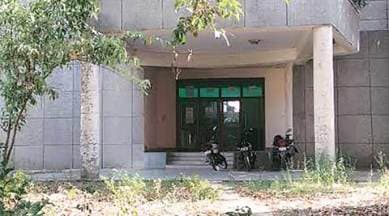Maggi Row: It started from six overworked men and a Gorakhpur lab
On March 26 last year, it was this lab, tucked away in a corner of the campus, that found the presence of monosodium glutamate (MSG), a flavour enhancer, in Maggi.

On a sultry weekday afternoon, five persons work among piles of files in a room inside the small building of Government Regional Public Analyst Laboratory on the Baba Raghav Das Medical College campus in Gorakhpur.
Like the quiet brick path leading up to the lab, with a carpet of fallen leaves on either side, the two-storey building appears deserted, with all its five occupants sitting in one room. “We are supposed to be at least 30 workers here,” says Sharda Kant Verma, Junior Analyst (Food) and in-charge of the lab.
monthly limit of free stories.
with an Express account.
While Verma is in-charge of the lab, three of his “friends and co-workers”, Ashish Rai, Arun Chowdhary and Shyam, carry the same designation of Junior Analyst (Food) as him. They all joined the lab together in 2008 when the Food Safety and Drug Administration Department was carved out of the Health Department in Uttar Pradesh.
With them is Anil Sharma, one of the two lab attendants; the other is on leave these days. The six round up the entire staff strength at the lab, of the required 30.
[related-post]
A new facility on the second floor meant to conduct additional tests such as for bacteria and fungus lies virtually locked due to lack of specialised experts.
One of the six food-testing labs across the state, the Gorakhpur facility caters to 15 districts in Basti, Devipatan, Gorakhpur and Faizabad mandals. The Faizabad mandal includes Barabanki, from where the Maggi samples that showed up MSG were collected on March 10 last year.
Pleased as they are at the impact their findings have made, the five analysts have little time to deliberate over the same. “We have to multi-task here, from cleaning glasses and beakers to locking the door as we leave,” says Shyam, stamping a paper.
The nine almirahs in the room are all full of similar paperwork.
It was just another day at work when the Maggi samples arrived in March last year. “All I remember is that we received two ‘chhota’ packs for testing,” Verma recalls.
Reticent about the methodology employed to detect MSG, Rai says, “There are multiple ways to detect a particular ingredient. The idea is to get the job done.”
Every month, the lab receives about 150-200 such samples, which the staff proceeds to divide under categories such as oil, milk and its products, namkeen, cooked food items, beverages, spices and condiments, cereals, fruits and vegetables, and miscellaneous items.
Given the amount of work and the few hands, the six devote alternate days to paperwork and lab tests. The testing facilities are on the first floor of the building. There are no computers to ease paper work.
While the deadline to give a result is 14 days, no one, including seniors who know the conditions at the lab, holds them to it.
Trying to explain the kind of tests they do, Chowdhary says, “Milk samples, for example, are tested for fat percentage, urea, solids which are not fat, carbonates, glucose, detergent, formalin, starch, sugar, etc. We do this manually.”
Recently, they found the head of a lizard in a namkeen of a “top brand”, and these days, they are matching the labelling on another top brand with the biscuits inside.
“The big brands usually do fudging in labelling,” says Rai. “Sometimes they have an item which is not labelled, or they claim they have a certain ingredient but it is missing.”
The officials treat A Handbook of Food Adulteration and Safety Laws as their Bible. The important regulations in the book are marked with a red sketch pen, and explanations, wherever required, have been added in pencil or with a blue pen.
Maggi samples tested by the Gorakhpur lab were found to contain MSG, contrary to its labelling of ‘No added MSG’.
Still, the four junior analysts at the Gorakhpur lab feel “Maggi would have gotten away with a fine of Rs 8,000-10,000 at most” had it not insisted on taking the samples for further testing to Central Food Laboratory in Kolkata. The latter found lead in excess of permissible limits in the samples, leading to the crackdown.
Having worked with food samples for so long, the officials admit the one thing they can no longer let pass is street food. Says Chowdhary, “At weddings, why is there a rush among children for chowmein noodles and chaat? (It is because while) we usually talk about MSG in parts per million, there it is added in grams to make food tastier.”
Advises Shyam, “If a chaat joint is very popular in your city, it probably means the owner is adding MSG and taste enhancers.”
While Verma chuckles that they don’t need any motivation — “We are self-motivated” — Rai admits the monotony gets to them. “We are still following decades old methods. The department should send us to seminars and other centres in the country so that we can update ourselves,” he says.
The Maggi attention though has its advantages, the junior analysts hope. It may finally lead to their promotion, due since 2013.